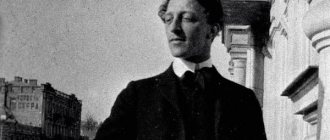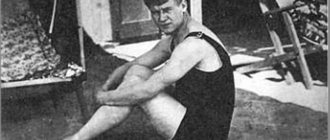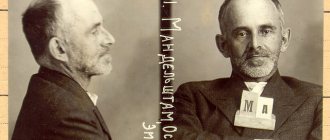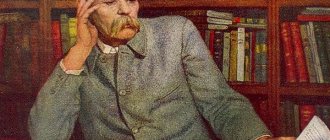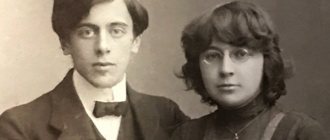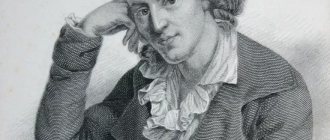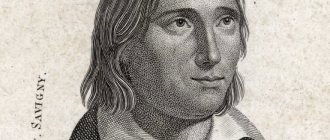Poet's family
His family played an important role in Khodasevich’s biography. His father's name was Felician Ivanovich, he came from a greatly impoverished noble family of Polish origin. Their last name was Masla-Khodasevichi; it is interesting that the hero of our article himself often called his father a Lithuanian.
Felician was a graduate of the Academy of Arts, but all his attempts to become a successful and fashionable painter ended in failure. As a result, he chose the path of a photographer. He worked in Moscow and Tula, among his famous works there are photographs of Lev Nikolaevich Tolstoy. Having earned money for the initial capital, he opened a store in Moscow, where he began selling photographic accessories. The poet himself outlined his father’s life in detail in the poem “Dactyls,” noting that he had to become a merchant solely out of necessity, but he never grumbled about it.
Khodasevich's mother, Sofya Yakovlevna, was the daughter of the popular European writer Yakov Aleksandrovich Brafman. She was 12 years younger than her husband, and they died in the same year - in 1911. Sophia's father eventually converted to Orthodoxy, devoting the rest of his life to the reform of Jewish life, approaching this issue exclusively from a Christian position. At the same time, Sophia herself was given to a Polish family as a child, in which she was raised as a devout Catholic.
Vladislav Khodasevich had an older brother named Mikhail, who became a famous and successful lawyer. It is known that Mikhail’s daughter Valentina became an artist. It was she who painted the famous portrait of the poet, who was her uncle. Describing the biography of Vladislav Khodasevich, it is worth noting that the poet, while studying at the university, lived in his brother’s house, maintaining friendly and warm relations with him until his final departure from Russia.
The poet's youth
Khodasevich was born in 1886, he was born in Moscow. In the biography of Vladislav Khodasevich, a special place was occupied by educational institutions in which he received the basics of knowledge. In 1904, the future poet graduated from the Third Moscow Gymnasium, going for higher education to the Faculty of Law of Moscow University.
But, after studying for only a year, he decided to abandon the legal profession and transferred to the Faculty of History and Philology. With several breaks, he studied there until the spring of 1910, but was never able to complete the course. This was largely prevented by the turbulent literary life in which he found himself at the center at that time. Khodasevich’s biography lists all the main events by date. The hero of our article at that time visited the so-called Teleshov Wednesdays, visited Valery Bryusov, at Zaitsev’s evenings, and constantly visited the literary and artistic circle. It was then that Khodasevich began to publish in domestic newspapers and magazines, in particular in the Golden Fleece and Libra.
Childhood and youth
The poet was born on May 28, 1886 in Moscow, then still in the Russian Empire. His childhood was spent in a fairly wealthy family of Felitsian Ivanovich Khodasevich, a Pole by nationality and a photographer by occupation, and a Jewish woman, Sofia Yakovlevna (nee Brafman).
On June 14, 1939, the Russian poet, critic, memoirist and literary historian Vladislav Khodasevich died in Paris.
The poet's mother,... Published by Ya-Tora Tuesday, June 14, 2021
Portrait of Vladislav Khodasevich in his youth
The significant age difference (21 years) did not prevent Vladislav Khodasevich from having a close relationship with his older brother Mikhail, a famous lawyer. They even lived together in 1904–1910, while the poet studied at Moscow University (now M.V. Lomonosov Moscow State University).
By the way, it was his brother who the young man looked up to when he entered the law faculty. In fact, the chosen profession turned out to be boring. In the fall of 1905, he transferred to the Faculty of History and Philology, but his awakened literary talent did not allow him to express himself here either. As a result, Vladislav Felitsianovich only has a general education from the 3rd Moscow Gymnasium.
Wedding
An important event in Khodasevich’s biography was his marriage to a spectacular and pretty blonde, as he himself called her, Marina Erastovna Ryndina. They get married in 1905. Those around and friends of the family noted that the poet’s wife was always distinguished by eccentric behavior, for example, she could appear at a party in Leda’s original costume with a live snake on her neck.
In the biography of the poet Khodasevich, this marriage became a bright, memorable, but short-lived episode. Already in 1907 he separated from his wife. Poems dedicated to Marina Ryndina have been preserved; most of them were included in a book called “Youth,” which was published in 1908.
Talking about the character and biography of Vladislav Felitsianovich Khodasevich, at that time many of his acquaintances noted that he was a great dandy, for example, Don-Aminado was remembered for his full-length student uniform, a shock of thick hair cut at the back of his head, with a deliberately indifferent and cold look in his dark eyes .
First steps in literature
After graduating from high school, in 1904, Vladislav Khodasevich entered Moscow University at the Faculty of Law, but in September of the same year he transferred to the Faculty of History and Philology. He studied unevenly: he either dropped out of the university, then returned to the ranks of students, but never completed the course. But from the middle of 1900 Khodasevich was known throughout literary Moscow. The poet regularly published poems in newspapers and magazines, was a regular at TV’s “Wednesdays” and creative evenings with B. Zaitsev, attended the Literary and Art Club, visited V. Bryusov, and in his free time he selflessly played cards.
In 1905, Vladislav Felitsianovich married the eccentric rich woman Marina Ryndina. Together they looked somewhat strange and at the same time very harmonious: a tall blond beauty and an incredibly thin poet in patent leather shoes and a long frock coat with a tenacious gaze of dark eyes sparkling from under pince-nez. Marina dressed only in black or white dresses, and decorated her high hair with an extendable bracelet trimmed with pearls and turquoise. In her house, Ryndina, in addition to cats and dogs, kept a parrot, a monkey and a tame snake. The shocking young lady sometimes wore the latter around her neck instead of a necklace. Once in the theater, while Marina was captivated by what was happening on stage, a snake crawled into the next box and caused a commotion. The fugitive was caught and returned to the owner, but the couple had to leave the theater. Another time, Ryndina herself became the cause of the commotion when, pretending to be Leda, she appeared at one of the parties naked with a crystal swan in her hands.
In winter, the young people lived in Moscow, and in the summer they went to Lidino, Marina’s estate near Bologim. Vladislav Felitsianovich wrote poetry, sat for hours reading Pushkin, and Ryndina, a magnificent horsewoman, galloped around the neighborhood on horseback from early morning in only a nightgown with a string of pearls around her neck. In 1905, Khodasevich published his first collection, “Youth,” many of the poems from which were dedicated to the poet’s love for a shocking blonde.
This marriage did not last long. One day, Vladislav Felitsianovich had to leave for St. Petersburg on publishing business, and in the meantime Marina became friends with Sergei Makovsky, publisher of the Apollo magazine. Discouraged by this turn of events, Khodasevich moved out of his ex-wife, rented several furnished rooms in “Balchug” and threw himself into work.
Health problems
In 1910, a difficult time began in Khodasevich’s biography. The poet begins to suffer from lung disease, this becomes a significant reason for his trip with friends to Venice. Together with the hero of our article, Boris Zaitsev, Mikhail Osorgin, Pavel Muratov and his wife Evgenia are going to Italy. In Italy, Khodasevich’s physical condition is aggravated by mental suffering. First, he experiences a love drama with Ekaterina Muratova, and in 1911, the death of both parents with an interval of just a few months.
The hero of our article finds salvation in a relationship with the younger sister of the then popular poet Georgy Chulkov. They got married to Anna Chulkova-Grentsion, who was practically the same age as him, in 1917. Such facts about the biography and family of Khodasevich are known to modern researchers. The poet, to whom this article is dedicated, raised Chulkova’s son from his first marriage, the future famous film actor Edgar Garrick. He is known for his role as Charles XII in Vladimir Petrov’s film epic “Peter the Great” and for the image of General Levitsky in the historical film “Heroes of Shipka” by Sergei Vasiliev.
The poet's second book
Even when briefly telling the biography of Khodasevich, it is necessary to mention his second book of poems, “Happy House,” which was published in 1914. In the six years that have passed since the release of the first collection “Youth,” Khodasevich managed to become a professional writer who made his living by translating, writing feuilletons and all kinds of reviews.
When the First World War began, Khodasevich received a “white ticket”; due to health reasons, he could not serve in the army, so he went to work for the periodicals “Morning of Russia”, “Russian Vedomosti”, and in 1917 he collaborated with the newspaper “Novaya Zhizn”. At the same time, his health continued to plague him; the hero of our article suffered from spinal tuberculosis, so he was forced to spend the summer in 1916 and 1917 in Koktebel, in the house of his friend and also famous poet Maximilian Voloshin.
Years of revolution
There are many interesting facts in Khodasevich’s biography. For example, it is known that he enthusiastically accepted the February Revolution, which took place in 1917. And after the October Revolution, at first he even agreed to cooperate with the Bolshevik government. However, he quickly came to the conclusion that under this government it was impossible to conduct free and independent literary activity. After this, he decided to withdraw from political issues and write exclusively for himself.
In 1918, his new book “The Jewish Anthology” was published, which he wrote in collaboration with Leib Yaffeon. This collection includes works by young Jewish poets. At the same time, he works as a secretary in the arbitration court, and conducts theoretical and practical classes in the literary studio of Proletkult.
Briefly describing Khodasevich’s biography, it should be mentioned that in 1918 he began to collaborate in the theater department of the People’s Commissariat for Education, worked directly in the repertoire section, then received a position as head of the Moscow department at the World Literature publishing house, which was founded by Maxim Gorky. Khodasevich also actively participates in the founding of a bookstore on shares; Muratov, Osorgin, Zaitsev and Griftsov are on duty at the counter in this shop in turn.
Moving to Petrograd
In the short biography of Vladislav Khodasevich, which is given in this article, it is necessary to note his move to Petrograd, which took place in November 1920. The poet was forced to do this because he developed an acute form of furunculosis. The disease emerged from the hunger and cold that raged in the country due to the Civil War.
In Petrograd, he was helped by Gorky, who helped him receive rations and two rooms in the writers’ dormitory “House of Arts.” Khodasevich would later write an essay about this experience entitled “Disk.”
In 1920, his third collection of poetry was published, which, perhaps, becomes the most famous in his career. It's called the "Path of Grain." It contains a poem of the same name, in which the poet describes the events of 1917. Khodasevich’s popularity has only grown since the release of this collection. The work of Khodasevich, whose biography we are now studying, for many is associated with the poems included in this collection.
New romantic relationships
At the very end of 1921, Khodasevich meets the poetess Nina Berberova, who turned out to be 15 years younger than him. He falls in love with her and in the summer of 1922 he leaves with his new muse for Berlin via Riga. Around the same time, Khodasevich’s fourth collection of poems, entitled “Heavy Lyre,” was published simultaneously in Berlin and St. Petersburg. Until 1923, the hero of our article lived in Berlin and communicated a lot with Andrei Bely.
Then for some time he neighbors with the family of Maxim Gorky, whose personality he himself values very highly. It is interesting that at the same time they speak unflatteringly about him as a writer. Khodasevich claimed that he saw authority in Gorky, but did not consider him a guarantor of his even hypothetical return to his homeland. He considers the most vulnerable qualities of his character to be his confused attitude towards truth and lies, which had a decisive influence on both his life and his work.
At the same time, Khodasevich and Gorky collaborate fruitfully, despite obvious differences in views. Together they edit the magazine “Conversation” (Shklovsky also helps them in this work), a total of six issues of this publication are published. It mainly publishes beginning Soviet authors.
Assessing Khodasevich’s work, researchers note that it was extremely specific and concise. The poet himself was like that in life. The hero of our article loved hoaxes, constantly admiring a certain “non-writing writer.” He himself often used hoaxes as a literary device, independently exposing them after some time. For example, I once wrote several poems under someone else’s name, even inventing the 18th century Russian poet Vasily Travnikov for this purpose. Khodasevich himself wrote all of Travnikov’s poems, and then read them at literary evenings and even published a study about Travnikov in 1936. Many admired Khodasevich, who discovered one of the greatest poets of the century before last; no one even imagined that Travnikov simply did not exist in reality.
Creative biography of V. F. Khodasevich
1. First poetic experiments. 2. The main features of Khodasevich’s lyrics. 3. “The Path of Grain” and “Heavy Lyre.” 4. Creativity in emigration. “The word is stronger than anything,” says Khodasevich, and for him it is a sacred means of liberation: a miracle of inspiration for Khodasevich is, first of all, a miracle of spiritual growth. S. Ya. Parnok V. F. Khodasevich was born in Moscow in 1886, in the family of an artist and photographer from impoverished Lithuanian nobles, who was lucky enough to capture L. N. Tolstoy himself for history. Khodasevich’s mother was the daughter of the famous writer Ya. A. Brafman. The family consisted of five brothers and two sisters. The boy began writing poetry at an early age - he was six years old. He soon realized that this was his calling. They remember a funny incident that happened to the poet in childhood - when he was seven years old, while visiting his uncle in the summer at his dacha, he learned that the poet A. N. Maikov lived nearby. Khodasevich went to him, met the poet and read his poems with expression. Since then he has been proudly. considered himself an acquaintance of the poet Maykov. The youngest and favorite child, he learned to read early. He received his education at the Moscow gymnasium, where he was friends with V. Ya. Bryusov’s brother, Alexander. Then he studied at the Faculty of Law of Moscow University, at the Faculty of History and Philology, but did not graduate from the university. At the age of eighteen, Khodasevich married M.E. Ryndina, a spectacular girl from a wealthy family. In 1905, his poems were first published, and soon a collection of poems, “Youth” (1908), was published, in which his feelings for his wife were poured out. Judging by the poems, this love could not be called mutual. My days dragged on, Without love, without strength, without complaint... If I cried, there would be no tears. My days have stretched out. Stunned by the silence, I hear flying mice, I hear the rustling of spider paws Behind my back. Already in this collection, the main properties of Khodasevich’s poetry were visible - accuracy, clarity, purity of language, classical traditional poetic form. Critics singled him out from the mass of poets and concluded that much can be expected from him in the future. His circle of contacts at that time included V. Ya. Bryusov, A. Bely, Ellis. Having divorced his wife at the end of 1907, she married S.K. Makovsky, publisher of Apollo magazine, and Khodasevich settled in furnished rooms. In 1910, he went to Venice, worked there, giving tours of museums and churches, and returned with new poems. Many of them a little later, in 1914, were included in the second collection of poems, “Happy House.” Look how empty and silent our night is: The pensive network of autumn stars Calls us to live calmly and die wisely, It’s easy to descend from the last cliff into the gentle valley. The poet's first two collections are usually classified as decadent lyric poetry; they were noted for special attention by the Acmeists. Khodasevich considered A. A. Blok his main teacher. Blok and Bely determined his literary path, as well as the fates of many other young poets. Khodasevich's early collections clearly show the influence of Blok's poems about the Beautiful Lady. The poet meets his second life partner, Anna, the ex-wife of his friend A. Ya. Bryusov. At the same time, the first work about A. S. Pushkin was published - “Pushkin’s First Step” - the beginning of his Pushkiniana, the theme of his whole life. “He loved Pushkin as a living person, and every line, every word and the slightest experience of Pushkin gave him great pleasure,” recalled his wife A.I. Chulkova. Vladislav Khodasevich becomes a professional writer. His literary works were published one after another - “Russian Poetry” (1914), “Igor Severyanin and Futurism” (1914), “Deceived Hopes” (1915), “Pushkin’s Petersburg Stories” (1915), “Derzhavin” (1916), “On new poems” (1916), “On “Gabriiliad”” (1918).
Khodasevich works at the Polza publishing house, translating Polish authors - A. Mickiewicz, V. Reymont, S. Przybyszewski. He attends Bryusov’s literary circle, where symbolists gather, and also attends “Wednesdays” of the realistic movement at N.D. Teleshev’s. Showing interest in many literary groups, Khodasevich always kept to himself. The poet publishes a lot in the anthology of the Musaget publishing house, in the magazines “Russian Thought”, “Apollo”, “Northern Notes”, “Grif”. Khodasevich accepted the revolution - both the February and the October - with joy, joined the Writers' Union, participated in revolutionary printed publications, and collaborated with the Bolsheviks, despite the disapproval of many colleagues. Soon the poet saw the light and changed his attitude towards the new system to the opposite; he had no illusions. He is overcome by misanthropy and wants to escape from reality, but where? The year 1920 was marked for Vladislav Felitsianovich with the publication of the book “The Path of Grain,” the third collection of poems dedicated to the memory of S.V. Kissin, the tragically deceased husband of Khodasevich’s sister, his only close friend. This book put him on a par with his well-known contemporaries. The main idea of the collection is contained in the poem of the same name: Russia will die and rise again in the same way as grain sprouts in the ground. The sower walks along even furrows. His father and grandfather followed the same paths. The grain sparkles with gold in his hand, But it must fall into the black ground. And where the blind worm makes its way, It will die and sprout at the promised time. So my soul follows the path of grain: Having descended into darkness, it dies - and it comes to life. And you, my country, and you, its people, will die and come to life, having passed through this year, Because the only wisdom has been given to us: All living things should follow the path of grain. The poet expressed all the pathos of his work in four lines: Fly, my little boat, fly, Careening and not looking for salvation. He is not on the path where inspiration takes... Researchers consider this post-revolutionary collection to be the most important in Khodasevich’s work. In it, the poet, remaining “behind the text,” evaluates what is happening from the point of view of history, rising above time, reflecting on the patterns of development of society, analyzing social and moral problems. The image of home runs through the poet’s entire work, from the first collections to the theme of homelessness and loneliness in emigration. The hearth house from “Happy Little House”, the family house in the collection “The Way of Grain” later turns into a “card house” in “The Heavy Lyre”. The fragility of the surrounding world and destruction are the leitmotif of the poet’s work. “Heavy Lyre” (1922) is the last collection of poems by Khodasevich, published before emigration. The author called this book the final poetic work. It is dominated by the theme of the collapse of illusory happiness, the fragility of the world as a result of human intervention. The next change of guidelines and values leads to destruction. Once again we notice that Khodasevich had no illusions about people and looked at life skeptically. With his third wife N.N. Berberova, Khodasevich emigrated to Latvia, Germany, and Italy. His third marriage lasted about ten years. Abroad, Khodasevich, under the tutelage of M. Gorky, edits the magazine “Conversation”, in 1925 he permanently moved to Paris, works as a prose writer, memoirist, literary critic (writes the books “Derzhavin. Biography”, “About Pushkin”. “Necropolis. Memoirs”, “ Bloody Food", "Literature in Exile", "Pan Tadeusz". These are the best artistic biographies. Khodasevich's political views since 1925 have been on the side of the White emigrants. He criticizes the Soviet system and Western philistinism. Khodasevich's life in exile, like his other compatriots, proceeded in need. He is sick, but does not stop working hard. Thanks to the memoirs and criticism of Khodasevich, we now learn more about his famous contemporaries - M. Gorky, A. A. Blok, A. Bel, N. S. Gumilyov, V. Ya Bryusov.
In 1926, he stopped publishing in the Latest News newspaper. A year later, Khodasevich released the series “European Night”. Gradually, poems disappear from his work, being replaced by criticism and polemics with G. V. Adamovich in emigrant publications. In the 30s, Khodasevich was overcome by disappointment in everything - in literature, in the political life of the emigration, in the USSR - he refused to return to his homeland. In exile he marries again. Khodasevich's fourth wife, a Jewish woman, died in a concentration camp. He himself died before the war began, in 1939, in a Paris hospital for the poor, after a serious operation. In the year of his death, his “Necropolis” was published - the best, according to critics, memoirs in Russian literature.
Life in exile
Speaking briefly about the biography and work of Khodasevich, it is necessary to mention that he finally understands that it is impossible to return to the USSR in 1925. At the same time, the hero of our article continues to publish in Soviet periodicals for some time; he writes feuilletons and articles about the activities of the GPU abroad. After the release of several high-profile notes on this topic, the Soviet authorities accuse him of “White Guardism.”
It came to the point that in the spring of 1925, the Soviet embassy in Rome refused to renew Khodasevich’s passport, inviting him to return to Moscow for this purpose. The poet refuses, finally cutting off all ties with the country.
In the same year, another important event took place in the biography of the Russian poet Khodasevich - together with Berberova he moved to Paris. The hero of our article is actively published in the emigrant newspapers “Last News” and “Days”. True, he leaves the latest edition, following the advice of Pavel Milyukov. At the beginning of 1927, Khodasevich headed the literary department of the newspaper Vozrozhdenie. In the same year, he released “Collected Poems,” which included a new cycle called “European Night.”
After this, Khodasevich almost completely stopped writing poetry, devoting most of his time to critical research. As a result, he becomes one of the leading critics of literature in Russian diaspora. In particular, he conducts polemics with Georgiy Ivanov and Georgiy Adamovich, discussing with them about the tasks of Russian literature in emigration, as well as in general about the purpose of poetry and the crisis in which it finds itself.
Published together with his wife Berberova. They publish reviews of Soviet literature under the pseudonym Gulliver. Khodasevich and Berberova openly support the poetry collective “Perekrestok” and are among the first to speak highly of the work of Vladimir Nabokov, who later becomes their close friend.
[edit] Biography
Khodasevich was born on May 28, 1886 in Moscow. Father, Felitsian Ivanovich, came from a Catholic impoverished noble family, mother, Sofya Yakovlevna, was the daughter of the famous Jewish writer Yakov Brafman, who later converted to Orthodoxy, despite this, Sofya was given up to be raised in a Polish Catholic family. The poet's elder brother, Mikhail Felitsianovich, became a famous lawyer.
In Moscow, Khodasevich’s classmate at the 3rd Moscow Gymnasium was Alexander Bryusov, brother of the poet Valery Bryusov. Viktor Hoffman studied a year older than Khodasevich, who greatly influenced the poet’s worldview.
After graduating from high school, Khodasevich entered Moscow University - first (in 1904) to the Faculty of Law, and in the fall of 1905 he transferred to the Faculty of History and Philology, where he studied intermittently until the spring of 1910, but did not complete the course. Since the mid-1900s, Khodasevich has been in the thick of Moscow literary life: he visits Valery Bryusov and Teleshov’s “Wednesdays”, the Literary and Artistic Circle, evenings with the Zaitsevs, and is published in magazines and newspapers, including “Vesakh” and “Golden Fleece”.
In 1905 he married Marina Erastovna Ryndina. The marriage was unhappy - at the end of 1907 they separated. Some of the poems from Khodasevich’s first book of poems, “Youth” (1908), are dedicated specifically to his relationship with Marina Ryndina.
In 1910-1911, Khodasevich suffered from lung disease, which was the reason for his trip with friends to Venice. From the end of 1911, the poet established a close relationship with the younger sister of the poet Georgy Chulkov, Anna Chulkova-Grentsion. In 1917 they got married.
Khodasevich’s next book was published only in 1914 and was called “Happy House”. In the six years that passed from writing “Youth” to “Happy House,” Khodasevich became a professional writer, earning a living from translations, reviews, feuilletons, etc.
During the First World War, the poet, who received a “white ticket” for health reasons, collaborated in “Russian Gazette”, “Morning of Russia”, and in 1917 - in “New Life”. Due to spinal tuberculosis, he spent the summers of 1916 and 1917 in Koktebel with the poet M. Voloshin.
In 1917, Khodasevich enthusiastically accepted the February Revolution and initially agreed to collaborate with the Bolsheviks after the October Revolution, but quickly came to the conclusion that “under the Bolsheviks, literary activity is impossible.” In 1918, together with L. Jaffe, he published the book “Jewish Anthology. Collection of young Jewish poetry"; worked as a secretary of the arbitration court, taught classes in the literary studio of the Moscow Proletkult. In 1918-19 he served in the repertory section of the theater department of the People's Commissariat for Education, in 1918 he headed the Moscow branch of the World Literature publishing house, founded by M. Gorky. He took part in the organization of a bookstore on shares (1918-19), where famous writers (Osorgin, Muratov, Zaitsev, B. Griftsov, etc.) were personally on duty at the counter. In March 1920, due to hunger and cold, he fell ill with an acute form of furunculosis and in November moved to Petrograd, where, with the help of M. Gorky, he received rations and two rooms in the writers' dormitory (the famous “House of Arts”, about which he later wrote the essay “Disk” ).
In 1920, his collection “The Path of Grain” with the title poem of the same name was published. At this time, his poems finally became widely known, and he was recognized as one of the first modern poets. However, on June 22, 1922, Khodasevich, together with the poetess Nina Berberova, whom he met in December 1921, left Russia and came to Berlin through Riga. In the same year, his collection “Heavy Lyre” was published.
In 1922-1923, while living in Berlin, he communicated a lot with Andrei Bely, in 1922-1925 (with interruptions) he lived in the family of M. Gorky, whom he highly valued as a person (but not as a writer), and recognized his authority. At the same time, Khodasevich and Gorky founded (with the participation of V. Shklovsky) and edited the magazine “Conversation” (six issues were published), where Soviet authors were published.
By 1925, Khodasevich and Berberova realized that returning to the USSR, and most importantly, life there was now impossible for them. Khodasevich published feuilletons about Soviet literature and articles about the activities of the GPU abroad in several publications, after which the Soviet press accused the poet of “White Guardism.” In March 1925, the Soviet embassy in Rome refused to renew Khodasevich’s passport, suggesting that he return to Moscow. He refused, finally becoming an emigrant.
In 1925, Khodasevich and Berberova moved to Paris, the poet was published in the newspapers “Days” and “Last News”, from where he left at the insistence of P. Milyukov. From February 1927 until the end of his life, he headed the literary department of the Vozrozhdenie newspaper. In the same year he released “Collected Poems” with a new cycle “European Night”. After this, Khodasevich practically stopped writing poetry, paying attention to criticism, and soon became a leading critic of Russian literature abroad. As a critic, he conducted polemics with G. Ivanov and G. Adamovich, in particular, about the tasks of emigration literature, the purpose of poetry and its crisis. Together with Berberova, he wrote reviews of Soviet literature (signed “Gulliver”), supported the poetry group “Crossroads,” and spoke highly of the work of V. Nabokov, who became his friend.
Since 1928, Khodasevich worked on his memoirs: they were included in the book “Necropolis. Memories" (1939). He wrote a biographical book “Derzhavin”, but Khodasevich abandoned the intention to write a biography of Pushkin due to deteriorating health (“Now I have given up on this, as well as on poetry. Now I have nothing,” he wrote on July 19, 1932 to Berberova , who left Khodasevich for N. Makeev in April). In 1933, he married Olga Margolina (1890-1942), who later died in Auschwitz.
Khodasevich's position in exile was difficult, he lived separately, preferred the suburbs to noisy Paris, he was respected as a poet and mentor of poetic youth, but was not loved. Vladislav Khodasevich died on June 14, 1939 in Paris, after surgery. He was buried on the outskirts of Paris in the Boulogne-Biancourt cemetery.
Memoirs of Khodasevich
In 1928, Khodasevich began writing his own memoirs, which are included in the book “Necropolis. Memories", she was published in 1939. In them, he talks in detail about his acquaintance and relationships with Bely, Bryusov, Gumilev, Yesenin, Gorky, Sologub, and the young poet Muni, with whom they were friends in their youth.
Khodasevich also writes a biographical book “Derzhavin”. He is well known as a major and scrupulous researcher of Pushkin's work. The hero of our article, having completed work on Derzhavin’s biography, planned to compose a biography of the “sun of Russian poetry,” but his sharply deteriorating health did not allow him to do this. In 1932, he wrote in a letter to Berberova that he was giving up on this work, as well as on poetry, realizing that he had nothing else left in his life. In April 1932 they separated.
The following year Khodasevich marries again. His new chosen one is Olga Borisovna Margolina. She is four years younger than her husband, originally from St. Petersburg. The poet lives in exile with his new wife. His situation is difficult and difficult, he communicates little with his compatriots, and keeps himself apart. In June 1939, Khodasevich died in Paris after another operation, which was supposed to maintain his health. He was buried near the French capital, in the Boulogne-Billancourt cemetery, he was 53 years old.
His last wife, Olga Margolina, did not survive her husband much. During World War II she was captured by the Germans. In 1942 she died in the concentration camp at Auschwitz.
Nina Berberova, with whom she lived a long life together, entered into an official marriage with the painter Nikolai Makeev in 1936; she remained on friendly terms with Khodasevich until his death. She endured the war in German-occupied Paris and divorced in 1947. In 1954, already in the USA, she married the famous music teacher and pianist Georgy Kochevitsky, and five years later she managed to obtain American citizenship.
In the 80s, she divorced Kochevitsky, and in 1989 she even came to the Soviet Union at the age of 88. She died in Philadelphia in 1993.
Vladislav Khodasevich short biography
Vladislav Khodasevich’s brief biography of the poet, prose writer, critic and memoirist is presented in this article.
Vladislav Khodasevich biography briefly
Khodasevich Vladislav Felitsianovich was born in Moscow on May 16 (28), 1886 in the family of a Polish nobleman. His father was a photographer and artist. He studied at Moscow University at the Faculty of Law, then the Faculty of History and Philology. I failed to graduate from school. His literary debut took place in 1905 with the publication of poems in the anthology “Grif”. In 1906, he began publishing in the magazines “Golden Fleece”, “Scales” and “Pereval”, as well as in the newspapers “Voice of Moscow”, “Rul”, “Morning of Russia” and “Russian Vedomosti”.
In 1909 he began translating texts from French and Polish. In 1917 he began working on translating Jewish poets. Thus, in 1921, the anthology “From Jewish Poets” was published. After the revolutionary events, he served in the theater and music section of the Moscow Council, taught classes at the Moscow Proletkult, worked at the Narkompros TEO, headed the Moscow branch of a publishing house called “World Literature” and the Book Chamber of the Moscow Council. A year before this, a book of poems, “The Path of Grain,” was published.
Having moved to Petrograd, Vladislav Felitsianovich receives housing in the House of Arts and meets Nina Berberova. Together with her in 1922, he went on a business trip to Riga and Berlin at the insistence of A.V. Lunacharsky. After hard work, his books “Heavy Lyre”, “Articles on Russian Poetry” and “Pushkin’s Poetic Economy” were published.
Abroad, he collaborates with Berlin magazines and newspapers, and also edits the magazine “Conversation” together with M. Gorky. During his life, Khodasevich moved a lot from place to place: to Prague, Marienbad, Venice, Rome, Turin, London, Belfast, Paris, Naples, Sorrento.
Beginning in 1925, he settled in Paris and, together with Aldanov, edited the literary department of the newspaper Dni. At the same time, it is published in “Modern Notes” and “Latest News”. He is an active member of the Green Lamp society, founded by Zinaida Gippius and Dmitry Merezhkovsky. From 1927 until the end of his life he worked for the newspaper Vozrozhdenie, publishing daily notes on Russian classics, emigration and the metropolis, and modern literature. A couple of weeks before his death, in 1939, a book of memoirs “Necropolis” was published about the bright personalities of the Silver Age. The poet died in Paris on June 14, 1939 .
Khodasevich Vladislav interesting facts:
- Was married 4 times. In 1905 he married Marina Erastovna Ryndina. After 2 years, the couple separated. He got married for the second time to Anna Chulkova - Grenzion in 1917. In 1922, he fell in love with the poetess Nina Berberova, with whom he left for Berlin via Riga. He later started a family with her. In April 1923 they separated. In 1924 he married Olga Borisovna Margolina.
- He was friends with the family of Maxim Gorky.
- I just loved hoaxes.
- He was a late child in the family and was born 2 weeks ahead of schedule. He was a very weak and sickly child.
